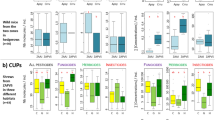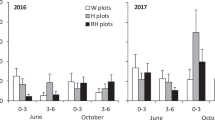Abstract
THE protracted persistence of DDT and some other organochlorine insecticides in soils is well documented1,2. While it has also been shown that these persistent residues can contaminate a resident fauna3, there has been little indication of the duration of this relationship once treatment ceases, except for observations covering a year or two4,5. We now present data of pesticide residues from small mammals covering a period of 9 years after single applications of DDT applied to forests at a rate of 0.89 kg/hectare (1 pound/acre). These treatments were for control of the spruce budworm, Choristoneura fumiferana (Clem.), in northern Maine, United States.
This is a preview of subscription content, access via your institution
Access options
Subscribe to this journal
Receive 51 print issues and online access
$199.00 per year
only $3.90 per issue
Buy this article
- Purchase on Springer Link
- Instant access to full article PDF
Prices may be subject to local taxes which are calculated during checkout
Similar content being viewed by others
References
Nash, R. G., and Woolson, E. A., Science, 157, 924 (1967).
Woodwell, G. M., and Martin, F. T., Science, 145, 481 (1964).
Woodwell, G. M., Wurster, C. F., and Isaacson, P. A., Science, 156, 821 (1967).
Cole, H., Barry, D., and Frear, D. E. H., Bull. Environmental Contamination Toxicol., 2, 127 (1967).
Meeks, R. O., J. Wildlife Management, 32, 376 (1968).
Webb, F. E., Blais, J. R., and Nash, R. W., Canad. Entomol., 93, 360 (1961).
Dimond, J. B., Kadunce, R. E., Getchell, A. S., and Blease, J. A., Bull. Environmental Contamination Toxicol., 3, 194 (1968).
Dimond, J. B., Kadunce, R. E., Getchell, A. S., and Blease, J. A., Ecology, 49, 759 (1968).
Wurster, C. F., Wurster, D. H., and Strickland, W. N., Science, 148, 90 (1965).
Bernard, R. F., and Gaertner, R. A., J. Mammal., 45, 272 (1964).
Jones, F. J. S., and Summers, D. D. B., Nature, 217, 1162 (1968).
Ames, P. L., in Pesticides in the Environment and Their Effects on Wildlife, Suppl. J. Appl. Ecol. (edit. by Moore, N. W.) (Blackwell, 1966).
Author information
Authors and Affiliations
Rights and permissions
About this article
Cite this article
DIMOND, J., SHERBURNE, J. Persistence of DDT in Wild Populations of Small Mammals. Nature 221, 486–487 (1969). https://doi.org/10.1038/221486a0
Received:
Issue Date:
DOI: https://doi.org/10.1038/221486a0
This article is cited by
-
Organochlorine residues in potential food items of maine bald eagles (Haliaeetus leucocephalus), 1966 and 1974
Bulletin of Environmental Contamination and Toxicology (1978)
-
DDT residues in forest biota: Further data
Bulletin of Environmental Contamination and Toxicology (1975)
-
The effects of DDT on energetics of the short-tailed shrew,Blarina brevicauda
Bulletin of Environmental Contamination and Toxicology (1974)
-
DDT and the frequency of implanted ova in the mouse
Bulletin of Environmental Contamination and Toxicology (1973)
-
Accumulation of chlorine-36 ring-labeled DDT residues in various tissues of two species of shrew
Archives of Environmental Contamination and Toxicology (1973)
Comments
By submitting a comment you agree to abide by our Terms and Community Guidelines. If you find something abusive or that does not comply with our terms or guidelines please flag it as inappropriate.



